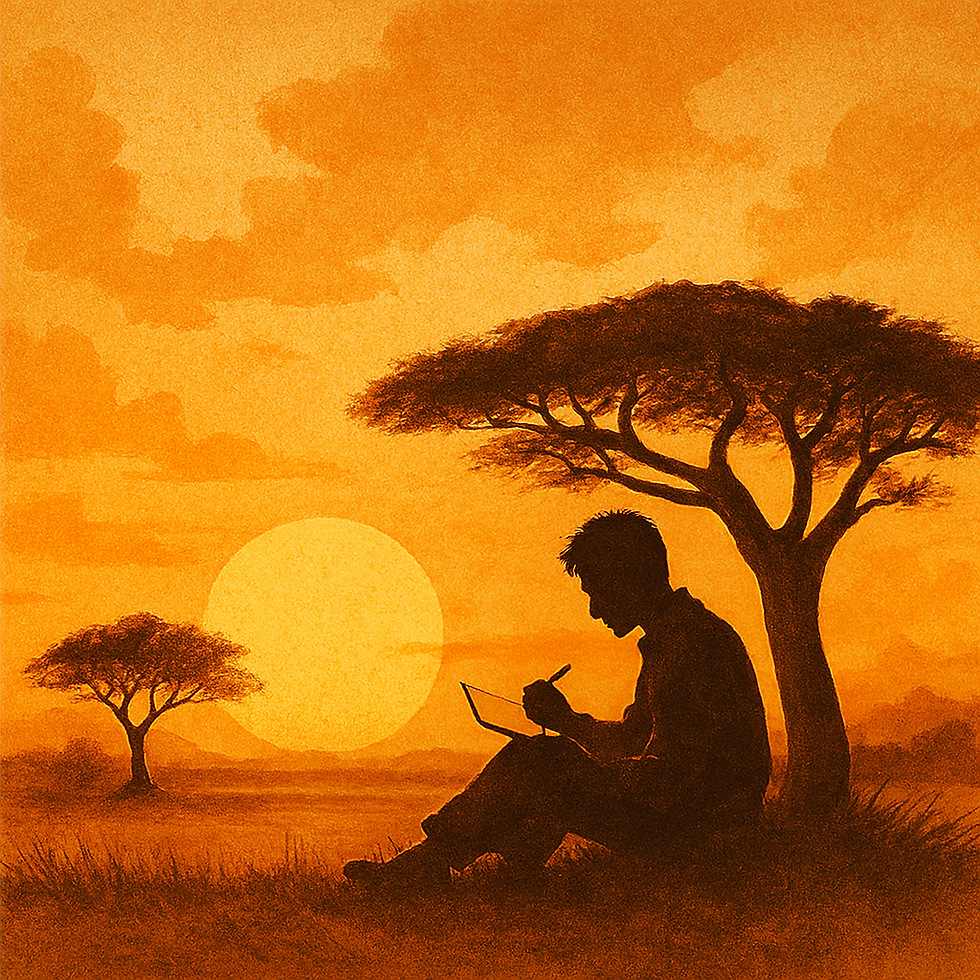My Roots: The History of the Kasigau People
- John Mwazemba
- May 17
- 4 min read
Updated: May 18

On the last day of my recent visit to my village of Buguta in Kasigau Ward (Taita), I sat outside the house, enjoying a view of sunlight and clouds, of buds climbing out of the soil and beautiful butterflies and grasshoppers happy and free in the kingdom of winged creatures. I could hear the faint barking of a distant dog, the far-off sounds of the village and the whispering wind—soft, elegiac, crooning like a love song. It was familiar, as if I had already lived a similar evening in the past, only that I thought I was happier that time. This is the scene they’d open with if this were a movie, I thought—a lingering shot of the blood-red sun as it set, angry and defiant, in the foreground of a sky that was constantly changing hues, the colours running into each other as if in the hands of a mad painter who kept changing his mind (or who was out of his mind)—sometimes stunning red and sombre, sometimes sea blue and playful and then a ruin of purple like the flower of a cactus plant.
The land lay quiet in a quivering mirage in the tropical evening, all the way to Kasigau Hill, the major landmark of Kasigau Ward. The Kasigau (my people) are the subject of a new historical novel entitled, Calamity of the Kasigau, by Makenzi K.G. It fictionalises the 1915 historical events and probably explains why the Kasigau are among the most marginalised people in Kenya—a forgotten people eking out a living on the Kenya-Tanzanian border.
The novel is a major break from the ordinary local novel as it is not only historical fiction but also introduces time travel, which is rare in Kenyan fiction. In the tradition of Lewis Carroll’s Alice’s Adventures in Wonderland, where Alice falls into a rabbit hole, in Calamity of the Kasigau, the twins (Betty and Safari) go with their uncle into a cave at Kasigau Hill and they find themselves taken back in time. When the twins open their eyes, it is 1915 during the World War 1 and they experience what they had read in history books.
The twins experience the tragedy of the Kasigau firsthand. Back in time, the Kasigau do not even know World War 1 is going on. The British in Kenya were fighting against the Germans in Tanzania (Tanganyika). To the Kasigau, all white people (wazungu) are brothers and this assumption turns tragic.
The Germans cross into Kenya and trick the Kasigau: “We would like to visit our brothers who are around here…please show us where we can find them,” says Grote. History has it that the German soldiers patrolling Kasigau in 1915 were led by Lt Freiherr Von Grote so the writer uses the names of real historical figures in a fictionalised narrative. Thinking the British and Germans are “brothers”, the Kasigau direct the Germans to the British military base.
The Germans not only annihilate the British soldiers at Kasigau Hill but also leave a note for the British: “The local community around your base at Kasigau willingly showed us where the British base was. Pass our regards to your loyal subjects for their help”. For this, the chief then, Chief (Kilongozi) Mwangojilo and his two assistants (Mwakuja and Mwadime) are sentenced to death for treason by the British. “Kilongozi and his two assistants were given hoes to dig their graves… The three men were pushed into their graves… shots were fired”. This heartbreaking execution is a true historical event though fictionalised in the novel.
The British decided to send the entire community to exile in Malindi. The people at the Coast had been warned by the British that the Kasigau were cannibals, so water sources were poisoned. Many people died from this poisoning. The Malindi exile lasted slightly over 20 years (from 1915-1936). By the time the Kasigau returned to their home, their brothers, the Sagalla (around and on Sagalla Hill) and the Dawida (in Upper Taita like Wundanyi), had enjoyed an advantage as they had gone to school while the Kasigau were away in exile.
While the Kasigau were away, their land (rich in various gemstones) was also taken and allocated to ranches and hunting blocks. The Kasigau are now squeezed in a small area.
This one action of sending the community to exile not only caused pain but also poverty and generally hampered development in Kasigau. I like to think that if the British had known of the hungry Kasigau faces that would be waiting for food aid many years later partly because of this exile, they would probably have let the Kasigau stay in their mineral-rich land.
The writer does a great job reminding us of the calamity of the Kasigau through historical fiction, which transports readers to another time and place, bringing the past to life, and highlighting how people lived. After reading the novel, I was excited that the story (I had heard many times before) is now in book form and then the moment passed, and a great weariness settled over me—weariness of history, of oppression, of the tears of my people and of successive deaf governments.










Wow, what a moving piece. Beautiful and shocking. Well-done, John.
Excellent piece, John. I have known for some time that the Taita people have PTSD to date from that first World War. trauma. You have done a commendable job of explaining the trauma through a trip back in time
Woow,this is a nice article,blessings sir